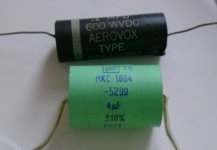Those big wound film or paper capacitors are the worst in many aspects.
They exhibit high inductance (1nH per mm of length) so they are not good for supply decoupling (ringing!!) or class D output filters (they allow the EMI to leak). They exhibit high capacitance to anything around them due to the big size, so they are not suitable for signal coupling due to humm and buzz pickup. They are microphonic and can work as tweeters too. The only useful features are low ESR and low loss.
I'm using arrays of small stacked films, in my class D amplifiers and everywhere, except in speaker crossovers, PFC mains input filters and sinewave inverter output filters.
BTW: I don't understand why people tends to associate trebble with coupling capacitors when there are zero volts across them at these frequencies. It's like claiming that you can see with no light, and of course you can, but where is the image coming from?
They exhibit high inductance (1nH per mm of length) so they are not good for supply decoupling (ringing!!) or class D output filters (they allow the EMI to leak). They exhibit high capacitance to anything around them due to the big size, so they are not suitable for signal coupling due to humm and buzz pickup. They are microphonic and can work as tweeters too. The only useful features are low ESR and low loss.
I'm using arrays of small stacked films, in my class D amplifiers and everywhere, except in speaker crossovers, PFC mains input filters and sinewave inverter output filters.
BTW: I don't understand why people tends to associate trebble with coupling capacitors when there are zero volts across them at these frequencies. It's like claiming that you can see with no light, and of course you can, but where is the image coming from?
Do the math. Typical inductance is a bit less than 1nH per mm of capacitor body length. A capacitor does not become inductive until above its resonant frequency, which is given by:
Fr=1/(2*pi*sqr(L*C))
For example, for 4.7uF and 50nH this gives 330Khz resonance, and it only becomes inductive above that frequency...
This would be disastrous for a class D amplifier or a switching power supply, but it's harmless for plain 20Hz-20Khz audio.
Fr=1/(2*pi*sqr(L*C))
For example, for 4.7uF and 50nH this gives 330Khz resonance, and it only becomes inductive above that frequency...
This would be disastrous for a class D amplifier or a switching power supply, but it's harmless for plain 20Hz-20Khz audio.
- Status
- This old topic is closed. If you want to reopen this topic, contact a moderator using the "Report Post" button.
